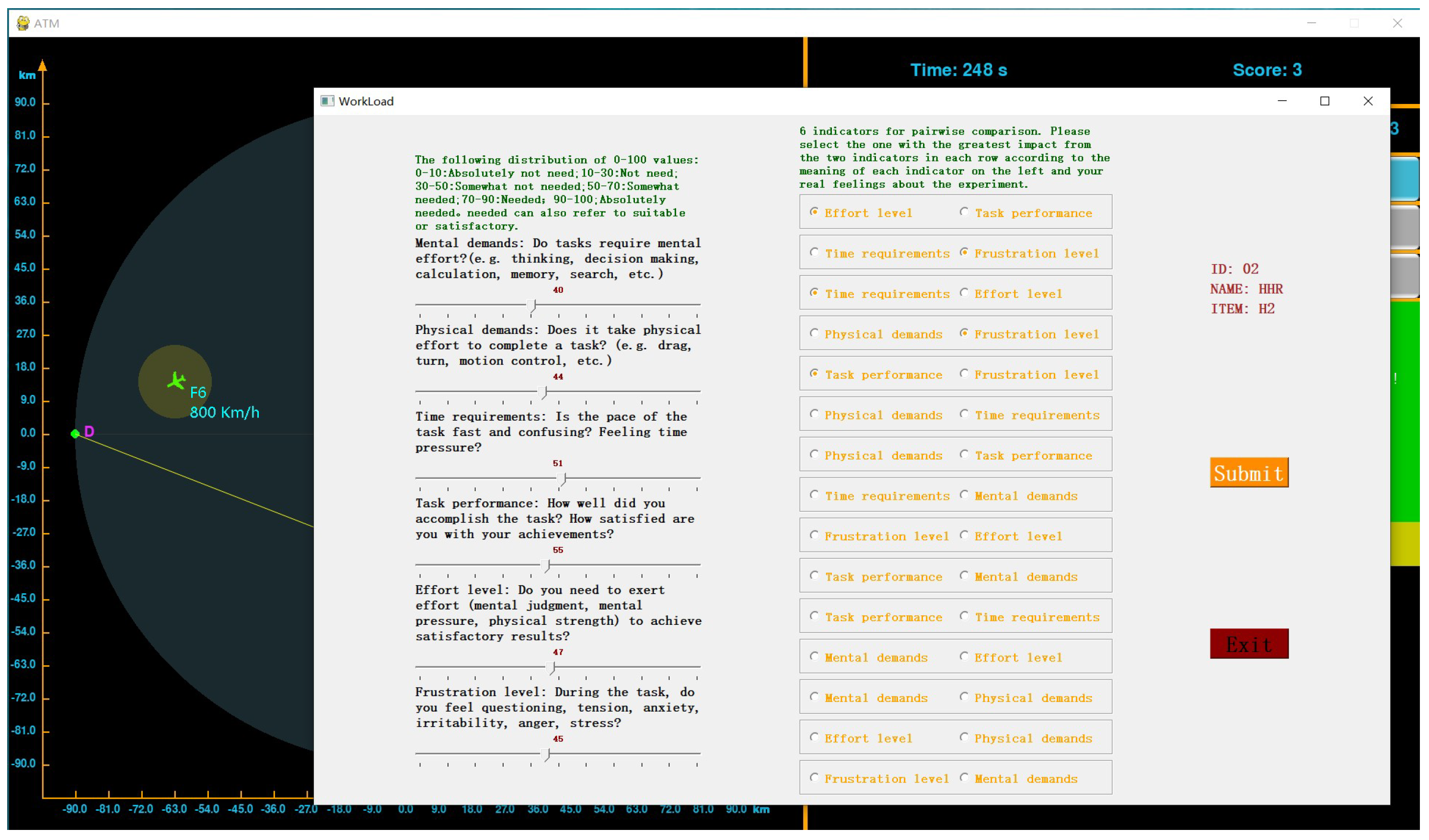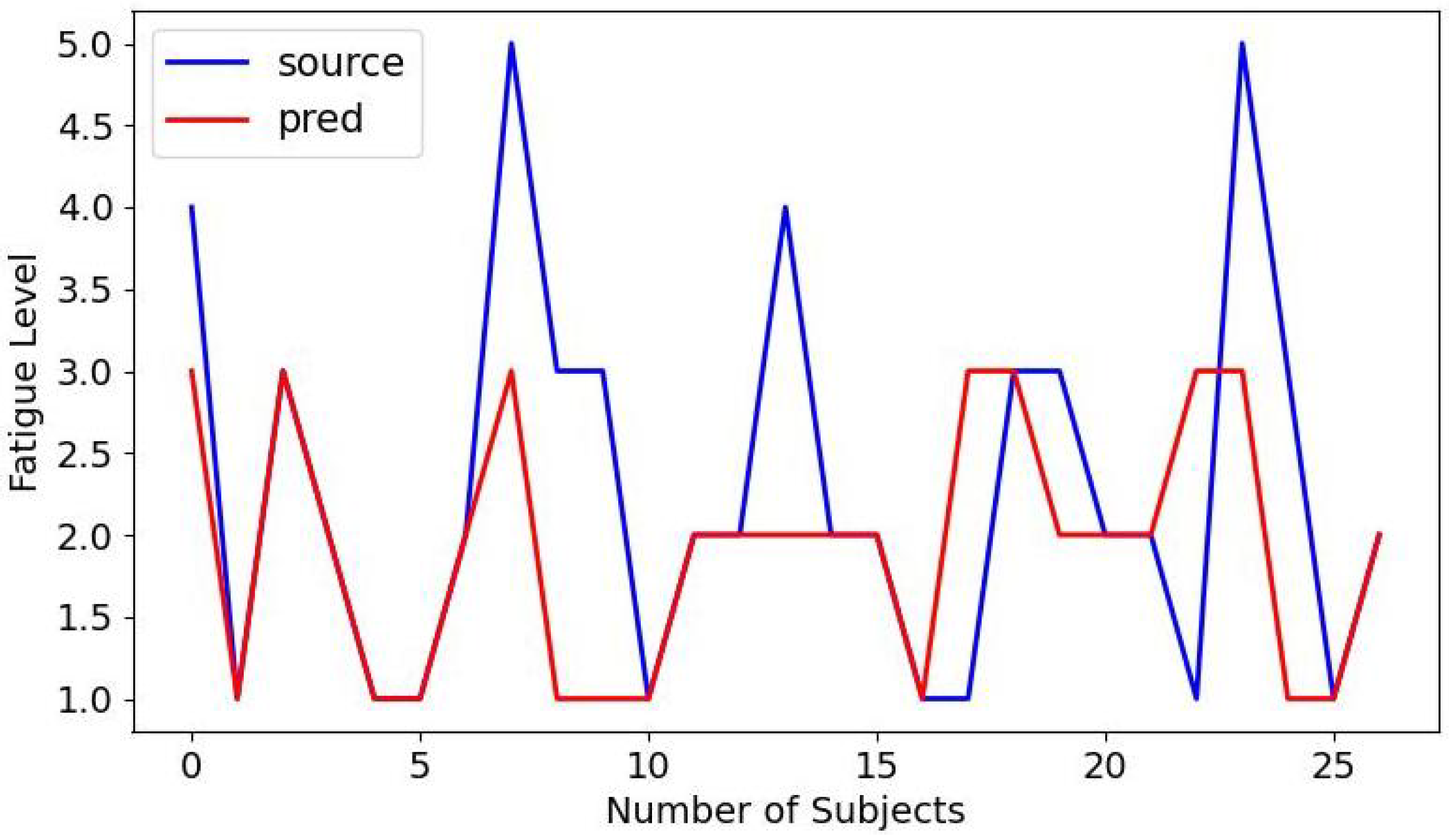Fatigue Detection of Air Traffic Controllers Through Their Eye Movements
Abstract
:1. Introduction
2. Related Work
3. Experimental Design
3.1. Experiment I: Conflict Monitoring and Warning
3.2. Experiment II: Simulation of Approach Control
3.3. Subjects
3.4. Simulation Procedure
3.4.1. Experiment I: Conflict Monitoring and Warning
- Step 1: Prepare the simulation environment to minimize the effects of light, particles, and other variables, and explain the experiment’s goal and procedures to the participants.
- Step 2: Let the participants become accustomed to the platform and simulation tasks; adjust their seats and other equipment.
- Step 3: Set-up and calibrate eye-tracking device.
- Step 4: Simulation starts, and the participants evaluate the traffic scenarios as instructed and complete the workload form.
3.4.2. Experiment II: Simulation of Approach Control
- Step 1: Prepare the simulation environment to minimize the effects of light, particles, and other variables, and explain the experiment’s goal and procedures to the participants.
- Step 2: Let air traffic controllers become acquainted with the airspace map, understand the requirements for entering/leaving altitude, runway direction, and pre-adjust radar screen size.
- Step 3: Set-up and calibrate eye-tracking device.
- Step 4: Simulation starts, and air traffic controllers provide air traffic control service to the flights, while periodically completing the KSS scale.
3.5. Algorithms for Eye Movement Data Processing
3.5.1. Determination of Fixation and Saccade
- Step 1: Identify the number of clusters, K, i.e., classifying the fixation points into K clusters.
- Step 2: Select K points at random to serve as initial centroids from the set of fixation drop points.
- Step 3: Measure the distance from each point to each centroid and assign each point to the cluster associated with the nearest centroid.
- Step 4: Once each centroid has a group of points assigned, update the algorithm to choose new centroids (for each cluster, compute its average position to determine the new centroid). This might not effectively identify glissades, which are scenarios in which the centroid gradually changes due to the fatigue of the extraocular muscles. Determining a fixation based on its distance from the centroid could result in several brief fixations instead of one prolonged fixation. This method requires careful consideration when applied.
- Step 5: Repeat Steps 3 and 4 iteratively until the termination condition is met (e.g., the clustering outcome no longer changes).
3.5.2. Statistics on Blink
3.6. Fatigue State Assessment
4. Results
4.1. Single Eye Movement Indicator to Detect Fatigue
4.1.1. Saccade Velocity
4.1.2. Saccade Duration
4.1.3. Saccade Distance
4.1.4. Pupil Diameter
4.1.5. Fixation Area Diameter
4.1.6. Fixation Duration
4.2. Evaluating the Importance of Eye Movement Metrics
4.2.1. Support Vector Machine
4.2.2. Random Forest
4.2.3. Summary
5. Discussion
6. Conclusions
Author Contributions
Funding
Institutional Review Board Statement
Informed Consent Statement
Data Availability Statement
Conflicts of Interest
References
- Hilburn, B. Cognitive Complexity in Air Traffic Control: A Literature Review. 2004. Available online: https://www.eurocontrol.int/node/9861 (accessed on 5 July 2024).
- Kallus, K.W.; Dittmann, A.; Van Damme, D.; Barbarino, M. Basic cognitive processes of air traffic controllers. In Engineering Psychology and Cognitive Ergonomics; Routledge: London, UK, 2020; pp. 113–120. [Google Scholar]
- Triyanti, V.; Azis, H.; Iridiastadi, H. Workload and fatigue assessment on air traffic controller. IOP Conf. Ser. Mater. Sci. Eng. 2020, 847, 012087. [Google Scholar] [CrossRef]
- Bongo, M.F.; Seva, R.R. Effect of Fatigue in Air Traffic Controllers’ Workload, Situation Awareness, and Control Strategy. Int. J. Aerosp. Psychol. 2021, 32, 1–23. [Google Scholar] [CrossRef]
- Skau, S.; Sundberg, K.; Kuhn, H.G. A Proposal for a Unifying Set of Definitions of Fatigue. Front. Psychol. 2021, 12, 739764. [Google Scholar] [CrossRef]
- Yu, X.; Chen, C.H.; Yang, H. Air traffic controllers’ mental fatigue recognition: A multi-sensor information fusion-based deep learning approach. Adv. Eng. Inform. 2023, 57, 102123. [Google Scholar] [CrossRef]
- Shi, S.Y.; Tang, W.Z.; Wang, Y.Y. A review on fatigue driving detection. ITM Web Conf. 2017, 12, 01019. [Google Scholar] [CrossRef]
- Chen, M.L.; Lu, S.Y.; Mao, I.F. Subjective symptoms and physiological measures of fatigue in air traffic controllers. Int. J. Ind. Ergon. 2019, 70, 1–8. [Google Scholar] [CrossRef]
- Gu, W.H.; Zhu, Y.; Chen, X.D.; He, L.F.; Zheng, B.B. Hierarchical CNN-based real-time fatigue detection system by visual-based technologies using MSP model. IET Image Process. 2018, 12, 2319–2329. [Google Scholar] [CrossRef]
- Li, F.; Chen, C.H.; Xu, G.; Khoo, L.P. Hierarchical eye-tracking data analytics for human fatigue detection at a traffic control center. IEEE Trans. Hum.-Mach. Syst. 2020, 50, 465–474. [Google Scholar] [CrossRef]
- Hartridge, H.; Thomson, L. Methods of investigating eye movements. Br. J. Ophthalmol. 1948, 32, 581. [Google Scholar] [CrossRef]
- Mahanama, B.; Jayawardana, Y.; Rengarajan, S.; Jayawardena, G.; Chukoskie, L.; Snider, J.; Jayarathna, S. Eye movement and pupil measures: A review. Front. Comput. Sci. 2022, 3, 733531. [Google Scholar] [CrossRef]
- Termsarasab, P.; Thammongkolchai, T.; Rucker, J.C.; Frucht, S.J. The diagnostic value of saccades in movement disorder patients: A practical guide and review. J. Clin. Mov. Disord. 2015, 2, 14. [Google Scholar] [CrossRef] [PubMed]
- Catalbas, M.C.; Cegovnik, T.; Sodnik, J.; Gulten, A. Driver fatigue detection based on saccadic eye movements. In Proceedings of the 2017 10th International Conference on Electrical and Electronics Engineering (ELECO), Bursa, Turkey, 30 November–2 December 2017; pp. 913–917. [Google Scholar]
- Van Orden, K.F.; Jung, T.P.; Makeig, S. Combined eye activity measures accurately estimate changes in sustained visual task performance. Biol. Psychol. 2000, 52, 221–240. [Google Scholar] [CrossRef] [PubMed]
- Sheridan, T.; Park, I.; Meyer, J.; Juergensohn, T.; Landry, S.; Yufik, Y. Conflict Monitoring in Air Traffic Control. IFAC Proc. Vol. 2001, 34, 543–548. [Google Scholar] [CrossRef]
- Ahlstrom, U.; Friedman-Berg, F.J. Using eye movement activity as a correlate of cognitive workload. Int. J. Ind. Ergon. 2006, 36, 623–636. [Google Scholar] [CrossRef]
- Paubel, P.V.; Averty, P.; Raufaste, E. Effects of an automated conflict solver on the visual activity of air traffic controllers. Int. J. Aviat. Psychol. 2013, 23, 181–196. [Google Scholar] [CrossRef]
- Di Stasi, L.L.; Marchitto, M.; Antolí, A.; Baccino, T.; Cañas, J.J. Approximation of on-line mental workload index in ATC simulated multitasks. J. Air Transp. Manag. 2010, 16, 330–333. [Google Scholar] [CrossRef]
- Imbert, J.P.; Hodgetts, H.M.; Parise, R.; Vachon, F.; Dehais, F.; Tremblay, S. Attentional costs and failures in air traffic control notifications. Ergonomics 2014, 57, 1817–1832. [Google Scholar] [CrossRef]
- Di Stasi, L.L.; McCamy, M.B.; Catena, A.; Macknik, S.L.; Canas, J.J.; Martinez-Conde, S. Microsaccade and drift dynamics reflect mental fatigue. Eur. J. Neurosci. 2013, 38, 2389–2398. [Google Scholar] [CrossRef]
- Imants, P.; de Greef, T. Eye metrics for task-dependent automation. In Proceedings of the 2014 European Conference on Cognitive Ergonomics, Vienna, Austria, 1–3 September 2014; pp. 1–4. [Google Scholar]
- Kang, Z.; Landry, S.J. Using scanpaths as a learning method for a conflict detection task of multiple target tracking. Hum. Factors 2014, 56, 1150–1162. [Google Scholar] [CrossRef]
- Marchitto, M.; Benedetto, S.; Baccino, T.; Cañas, J.J. Air traffic control: Ocular metrics reflect cognitive complexity. Int. J. Ind. Ergon. 2016, 54, 120–130. [Google Scholar] [CrossRef]
- Kearney, P.; Li, W.C.; Yu, C.S.; Braithwaite, G. The impact of alerting designs on air traffic controller’s eye movement patterns and situation awareness. Ergonomics 2019, 62, 305–318. [Google Scholar] [CrossRef] [PubMed]
- Yoshida, H.; Aoyama, H.; Inoue, S.; Kanno, T.; Furuta, K. Analyzing positive and negative effects of salience in air traffic control tasks. In Advances in Human Aspects of Transportation, Proceedings of the AHFE 2017 International Conference on Human Factors in Transportation, Los Angeles, CA, USA, 17–21 July 2017; Springer: Cham, Switzerland, 2018; pp. 70–78. [Google Scholar]
- Di Flumeri, G.; De Crescenzio, F.; Berberian, B.; Ohneiser, O.; Kramer, J.; Aricò, P.; Borghini, G.; Babiloni, F.; Bagassi, S.; Piastra, S. Brain–computer interface-based adaptive automation to prevent out-of-the-loop phenomenon in air traffic controllers dealing with highly automated systems. Front. Hum. Neurosci. 2019, 13, 296. [Google Scholar] [CrossRef] [PubMed]
- Eisma, Y.B.; Borst, C.; Paassen, R.v.; Winter, J.D. Augmented visual feedback: Cure or distraction? Hum. Factors 2021, 63, 1156–1168. [Google Scholar] [CrossRef] [PubMed]
- Wang, Y.; Wang, L.; Lin, S.; Cong, W.; Xue, J.; Ochieng, W. Effect of Working Experience on Air Traffic Controller Eye Movement. Engineering 2021, 7, 488–494. [Google Scholar] [CrossRef]
- Li, Q.; Ng, K.K.; Simon, C.; Yiu, C.Y.; Lyu, M. Recognising situation awareness associated with different workloads using EEG and eye-tracking features in air traffic control tasks. Knowl.-Based Syst. 2023, 260, 110179. [Google Scholar] [CrossRef]
- John, A.R.; Singh, A.K.; Do, T.T.N.; Eidels, A.; Nalivaiko, E.; Gavgani, A.M.; Brown, S.; Bennett, M.; Lal, S.; Simpson, A.M.; et al. Unraveling the physiological correlates of mental workload variations in tracking and collision prediction tasks. IEEE Trans. Neural Syst. Rehabil. Eng. 2022, 30, 770–781. [Google Scholar] [CrossRef]
- Li, Y.F.; Lye, S.W.; Rajamanickam, Y. Assessing attentive monitoring levels in dynamic environments through visual neuro-assisted approach. Heliyon 2022, 8, e09067. [Google Scholar] [CrossRef]
- Alberts, M.; Vercoulen, J.H.; Bleijenberg, G. Assessment of fatigue—The practical utility of the subjective feeling of fatigue in research and clinical practice. In Assessment in Behavioral Medicine; Routledge: London, UK, 2013; pp. 321–348. [Google Scholar]
- Ji, Y.; Wang, S.; Lu, Y.; Wei, J.; Zhao, Y. Eye and mouth state detection algorithm based on contour feature extraction. J. Electron. Imaging 2018, 27, 051205. [Google Scholar] [CrossRef]
- Bendak, S.; Rashid, H.S. Fatigue in aviation: A systematic review of the literature. Int. J. Ind. Ergon. 2020, 76, 102928. [Google Scholar] [CrossRef]
- Diepeveen, H.; van Miltenburg, M.; van Drongelen, A.; van den Oever, F.; van Dijk, H. Fatigue-Indicator in Operational Settings: Vocal Changes. In Proceedings of the 21st Congress of the International Ergonomics Association (IEA 2021), Online, 13–18 June 2021; Black, N.L., Neumann, W.P., Noy, I., Eds.; Springer: Cham, Switzerland, 2021; pp. 128–135. [Google Scholar]
- Yildiz, B.C.; Gzara, F.; Elhedhli, S. Airline crew pairing with fatigue: Modeling and analysis. Transp. Res. Part C Emerg. Technol. 2017, 74, 99–112. [Google Scholar] [CrossRef]
- Ruishan, S.; Yi, C.; Libin, S. Fatigue assessment method of controllers based on CFF. China Saf. Sci. J. 2022, 32, 192. [Google Scholar]
- Zhang, J.; Chen, Z.; Liu, W.; Ding, P.; Wu, Q. A Field Study of Work Type Influence on Air Traffic Controllers’ Fatigue Based on Data-Driven PERCLOS Detection. Int. J. Environ. Res. Public Health 2021, 18, 11937. [Google Scholar] [CrossRef] [PubMed]
- Wang, Y.; Cong, W.; Dong, B.; Wu, F.; Hu, M. Statistical analysis of air traffic controllers’ eye movements. In Proceedings of the 11th USA/Europe ATM R&D Seminar, Lisbon, Portugal, 23–26 June 2015; Volume 2015, p. 9. [Google Scholar]
- Nguyen, H.T.; Isaacowitz, D.M.; Rubin, P.A. Age-and fatigue-related markers of human faces: An eye-tracking study. Ophthalmology 2009, 116, 355–360. [Google Scholar] [CrossRef] [PubMed]
- Xiong, R.; Wang, Y.; Tang, P.; Cooke, N.J.; Ligda, S.V.; Lieber, C.S.; Liu, Y. Predicting separation errors of air traffic controllers through integrated sequence analysis of multimodal behaviour indicators. Adv. Eng. Inform. 2023, 55, 101894. [Google Scholar] [CrossRef]


















Disclaimer/Publisher’s Note: The statements, opinions and data contained in all publications are solely those of the individual author(s) and contributor(s) and not of MDPI and/or the editor(s). MDPI and/or the editor(s) disclaim responsibility for any injury to people or property resulting from any ideas, methods, instructions or products referred to in the content. |
© 2024 by the authors. Licensee MDPI, Basel, Switzerland. This article is an open access article distributed under the terms and conditions of the Creative Commons Attribution (CC BY) license (https://creativecommons.org/licenses/by/4.0/).
Share and Cite
Hu, Y.; Shen, H.; Pan, H.; Wei, W. Fatigue Detection of Air Traffic Controllers Through Their Eye Movements. Aerospace 2024, 11, 981. https://doi.org/10.3390/aerospace11120981
Hu Y, Shen H, Pan H, Wei W. Fatigue Detection of Air Traffic Controllers Through Their Eye Movements. Aerospace. 2024; 11(12):981. https://doi.org/10.3390/aerospace11120981
Chicago/Turabian StyleHu, Yi, Haoran Shen, Hui Pan, and Wenbin Wei. 2024. "Fatigue Detection of Air Traffic Controllers Through Their Eye Movements" Aerospace 11, no. 12: 981. https://doi.org/10.3390/aerospace11120981
APA StyleHu, Y., Shen, H., Pan, H., & Wei, W. (2024). Fatigue Detection of Air Traffic Controllers Through Their Eye Movements. Aerospace, 11(12), 981. https://doi.org/10.3390/aerospace11120981




